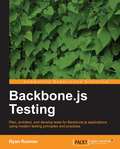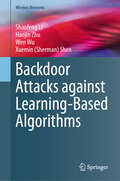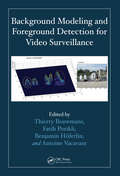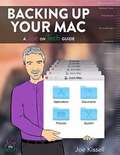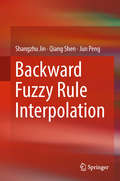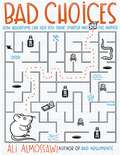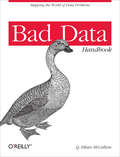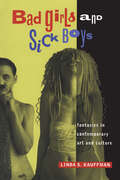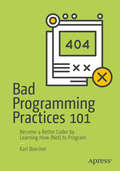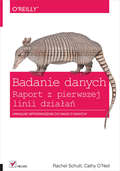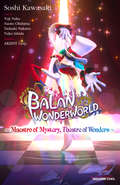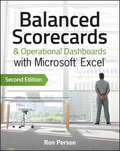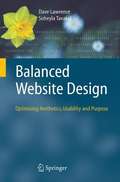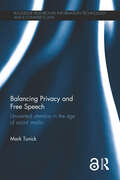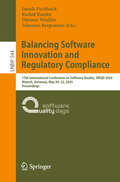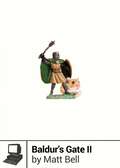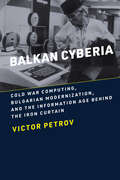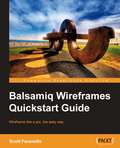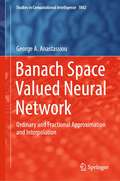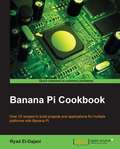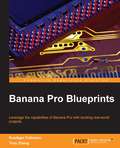- Table View
- List View
Backbone.js Testing
by Ryan RoemerThis book is packed with the step by step tutorial and instructions in recipe format helping you setup test infrastructure and gradually advance your skills to plan, develop, and test your backbone applications.If you are a JavaScript developer looking for recipes to create and implement test support for your backbone application, then this book is ideal for you.
Backdoor Attacks against Learning-Based Algorithms (Wireless Networks)
by Haojin Zhu Shaofeng Li Xuemin (Sherman) Shen Wen WuThis book introduces a new type of data poisoning attack, dubbed, backdoor attack. In backdoor attacks, an attacker can train the model with poisoned data to obtain a model that performs well on a normal input but behaves wrongly with crafted triggers. Backdoor attacks can occur in many scenarios where the training process is not entirely controlled, such as using third-party datasets, third-party platforms for training, or directly calling models provided by third parties. Due to the enormous threat that backdoor attacks pose to model supply chain security, they have received widespread attention from academia and industry. This book focuses on exploiting backdoor attacks in the three types of DNN applications, which are image classification, natural language processing, and federated learning.Based on the observation that DNN models are vulnerable to small perturbations, this book demonstrates that steganography and regularization can be adopted to enhance the invisibility of backdoor triggers. Based on image similarity measurement, this book presents two metrics to quantitatively measure the invisibility of backdoor triggers. The invisible trigger design scheme introduced in this book achieves a balance between the invisibility and the effectiveness of backdoor attacks. In the natural language processing domain, it is difficult to design and insert a general backdoor in a manner imperceptible to humans. Any corruption to the textual data (e.g., misspelled words or randomly inserted trigger words/sentences) must retain context-awareness and readability to human inspectors. This book introduces two novel hidden backdoor attacks, targeting three major natural language processing tasks, including toxic comment detection, neural machine translation, and question answering, depending on whether the targeted NLP platform accepts raw Unicode characters.The emerged distributed training framework, i.e., federated learning, has advantages in preserving users' privacy. It has been widely used in electronic medical applications, however, it also faced threats derived from backdoor attacks. This book presents a novel backdoor detection framework in FL-based e-Health systems. We hope this book can provide insightful lights on understanding the backdoor attacks in different types of learning-based algorithms, including computer vision, natural language processing, and federated learning. The systematic principle in this book also offers valuable guidance on the defense of backdoor attacks against future learning-based algorithms.
Background Modeling and Foreground Detection for Video Surveillance
by Fatih Porikli Thierry Bouwmans Benjamin Höferlin Antoine V AcavantBackground modeling and foreground detection are important steps in video processing used to detect robustly moving objects in challenging environments. This requires effective methods for dealing with dynamic backgrounds and illumination changes as well as algorithms that must meet real-time and low memory requirements.Incorporating both establish
Backing Up Your Mac
by Joe KissellThe Definitive Guide to Mac Backups <P><P> Your Mac contains valuable and sometimes irreplaceable files--family photos and videos, business documents, your unfinished novel... not to mention personal data such as email, contacts, and calendars. Without great backups, all of that data could disappear in an instant. We don't like to think about theft, fire, and natural disasters, but these things happen. So do hard drive crashes and other malfunctions (not to mention user error). <P> Your best insurance against losing data forever is a thorough, carefully designed backup plan. You don't have to spend a ton of money or be a technical whiz to back up your Mac. This book helps you design a sensible backup strategy, choose and configure the best backup hardware and software for your needs, and understand how to make your backups as painless as possible. <P> * Learn Joe's simple, three-prong strategy for bulletproof Mac backups. <P> * Decide whether Time Machine is right for you--and if so, learn how to use it for backing up and restoring data. <P> * Discover alternatives to Time Machine for storing multiple versions of your files. <P> * Find out why and how to create a bootable duplicate (or clone) of your Mac's startup volume. <P> * Choose the best hardware for backing up your data. <P> * Learn about offsite storage, including cloud backup services. <P> * Know exactly what you'll need to do if disaster strikes. <P> * Deal with special backup needs, such as large video files, backups while on the road, and backing up a small network.
Backing Up Your Mac
by Joe KissellThe data on every Mac should be backed up to protect against theft, hardware failure, user error, and other catastrophes. This book helps you design a sensible backup strategy, choose and configure the best backup hardware and software for your needs, and understand how to make your backups as painless as possible.
Backup & Recovery
by W. Curtis PrestonIn this resource for database and system administrators, Preston provides clear instructions for using open source tools to backup and recover vital systems. All types of systems needing protection are covered, from basic Linux, Windows, and Mac OS workstations to complex DB2, Oracle, and Sybase databases. He also presents clear criteria for evaluating both commercial and open source solutions as well as various types of backup hardware. Preston has been designing data-protection systems since 1993. Annotation ©2007 Book News, Inc. , Portland, OR (booknews. com)
Backup & Recovery: Inexpensive Backup Solutions for Open Systems
by W. Curtis PrestonPacked with practical, freely available backup and recovery solutions for Unix, Linux, Windows, and Mac OS X systems -- as well as various databases -- this new guide is a complete overhaul of Unix Backup & Recovery by the same author, now revised and expanded with over 75% new material.Backup & Recovery starts with a complete overview of backup philosophy and design, including the basic backup utilities of tar, dump, cpio, ntbackup, ditto, and rsync. It then explains several open source backup products that automate backups using those utilities, including AMANDA, Bacula, BackupPC, rdiff-backup, and rsnapshot. Backup & Recovery then explains how to perform bare metal recovery of AIX, HP-UX, Linux, Mac OS, Solaris, VMWare, & Windows systems using freely-available utilities. The book also provides overviews of the current state of the commercial backup software and hardware market, including overviews of CDP, Data De-duplication, D2D2T, and VTL technology. Finally, it covers how to automate the backups of DB2, Exchange, MySQL, Oracle, PostgreSQL, SQL-Server, and Sybase databases - without purchasing a commercial backup product to do so.For environments of all sizes and budgets, this unique book shows you how to ensure data protection without resorting to expensive commercial solutions. You will soon learn to:Automate the backup of popular databases without a commercial utilityPerform bare metal recovery of any popular open systems platform, including your PC or laptopUtilize valuable but often unknown open source backup productsUnderstand the state of commercial backup software, including explanations of CDP and data de-duplication softwareAccess the current state of backup hardware, including Virtual Tape Libraries (VTLs)
Backward Fuzzy Rule Interpolation
by Qiang Shen Shangzhu Jin Jun PengThis book chiefly presents a novel approach referred to as backward fuzzy rule interpolation and extrapolation (BFRI). BFRI allows observations that directly relate to the conclusion to be inferred or interpolated from other antecedents and conclusions. Based on the scale and move transformation interpolation, this approach supports both interpolation and extrapolation, which involve multiple hierarchical intertwined fuzzy rules, each with multiple antecedents. As such, it offers a means of broadening the applications of fuzzy rule interpolation and fuzzy inference. The book deals with the general situation, in which there may be more than one antecedent value missing for a given problem. Two techniques, termed the parametric approach and feedback approach, are proposed in an attempt to perform backward interpolation with multiple missing antecedent values. In addition, to further enhance the versatility and potential of BFRI, the backward fuzzy interpolation method is extended to support α-cut based interpolation by employing a fuzzy interpolation mechanism for multi-dimensional input spaces (IMUL). Finally, from an integrated application analysis perspective, experimental studies based upon a real-world scenario of terrorism risk assessment are provided in order to demonstrate the potential and efficacy of the hierarchical fuzzy rule interpolation methodology.
Bad Boy Ballmer: The Man Who Rules Microsoft
by Fredric Alan MaxwellIn Jan. 2000 Bill Gates gave his responsibilities & the title CEO of Microsoft to his best friend, Steve Ballmer, who had been at Gates's side almost since the company's earliest days. Ballmer's life is an incredible story of tremendous ambition, genius, arrogance, & charisma. This enlightening biography -- based on in-depth study & interviews with former Microsoft insiders -- provides the complete, controversial narrative of one of the technology industry's most influential & talked-about figures. It is also the definitive story of the Bill Gates/Steve Ballmer relationship, from their 1974 meeting at a Harvard dorm. The book shows how Ballmer & Gates work together & provides a revealing look at one of the masterminds of the technological age.
Bad Choices: How Algorithms Can Help You Think Smarter and Live Happier
by Ali AlmossawiA relatable, interactive, and funny exploration of algorithms, those essential building blocks of computer science - and of everyday life - from the author of the wildly popular Bad Arguments.Algorithms -- processes that are made up of unambiguous steps and do something useful -- make up the very foundations of computer science. Yet, they also inform our choices in approaching everyday tasks, from managing a pile of clothes fresh out of the dryer to deciding what music to listen to.With Bad Choices, Ali Almossawi, presents twelve scenes from everyday life that help demonstrate and demystify the fundamental algorithms that drive computer science, bringing these seemingly elusive concepts into the understandable realms of the everyday.Readers will discover how:· Matching socks can teach you about search and hash tables· Planning trips to the store can demonstrate the value of stacks· Deciding what music to listen to shows why link analysis is all-important· Crafting a succinct Tweet draws on ideas from compression· Making your way through a grocery list helps explain priority queues and traversing graphs · And moreAs you better understand algorithms, you'll also discover what makes a method faster and more efficient, helping you become a more nimble, creative problem-solver, ready to face new challenges. Bad Choices will open the world of algorithms to all readers making this a perennial go-to for fans of quirky, accessible science books.
Bad Data Handbook: Cleaning Up The Data So You Can Get Back To Work
by Q. Ethan McCallumWhat is bad data? Some people consider it a technical phenomenon, like missing values or malformed records, but bad data includes a lot more. In this handbook, data expert Q. Ethan McCallum has gathered 19 colleagues from every corner of the data arena to reveal how they’ve recovered from nasty data problems.From cranky storage to poor representation to misguided policy, there are many paths to bad data. Bottom line? Bad data is data that gets in the way. This book explains effective ways to get around it.Among the many topics covered, you’ll discover how to:Test drive your data to see if it’s ready for analysisWork spreadsheet data into a usable formHandle encoding problems that lurk in text dataDevelop a successful web-scraping effortUse NLP tools to reveal the real sentiment of online reviewsAddress cloud computing issues that can impact your analysis effortAvoid policies that create data analysis roadblocksTake a systematic approach to data quality analysis
Bad Girls and Sick Boys: Fantasies in Contemporary Art and Culture
by Linda S. KauffmanLinda S. Kauffman turns the pornography debate on its head with this audacious analysis of recent taboo-shattering fiction, film, and performance art. Investigating the role of fantasy in art, politics, and popular culture, she shows how technological advances in medicine and science (magnetic resonance imaging, computers, and telecommunications) have profoundly altered our concepts of the human body. Cyberspace is producing new forms of identity and subjectivity. The novelists, filmmakers, and performers in Bad Girls and Sick Boys are the interpreters of these brave new worlds, cartographers who are busy mapping the fin-de-millennium environment that already envelops us.Bad Girls and Sick Boys offers a vital and entertaining tour of the current cultural landscape. Kauffman boldly connects the dots between the radical artists who shatter taboos and challenge legal and aesthetic conventions. She links writers like John Hawkes and Robert Coover to Kathy Acker and William Vollmann; filmmakers like Ngozi Onwurah and Isaac Julien to Brian De Palma and Gus Van Sant; and performers like Carolee Schneemann and Annie Sprinkle to the visual arts. Kauffman's lively interviews with J. G. Ballard, David Cronenberg, Bob Flanagan, and Orlan add an extraordinary dimension to her timely and convincing argument.
Bad Programming Practices 101: Become a Better Coder by Learning How (Not) to Program
by Karl BeecherThis book takes a humorous slant on the programming practice manual by reversing the usual approach: under the pretence of teaching you how to become the world’s worst programmer who generally causes chaos, the book teaches you how to avoid the kind of bad habits that introduce bugs or cause code contributions to be rejected.Why be a code monkey when you can be a chaos monkey? OK, so you want to become a terrible programmer. You want to write code that gets vigorously rejected in review. You look forward to reading feedback plastered in comments like "WTF???". Even better, you fantasize about your bug-ridden changes sneaking through and causing untold chaos in the codebase. You want to build a reputation as someone who writes creaky, messy, error-prone garbage that frustrates your colleagues. Bad Programming Practices 101 will help you achieve that goal a whole lot quicker by teaching you an array of bad habits that will allow you to cause maximum chaos.Alternatively, you could use this book to identify those bad habits and learn to avoid them. The bad practices are organized into topics that form the basis of programming (layout, variables, loops, modules, and so on). It's been remarked that to become a good programmer, you must first write 10,000 lines of bad code to get it all out of your system. This book is aimed at programmers who have so far written only a small portion of that. By learning about poor programming habits, you will learn good practices. In addition, you will find out the motivation behind each practice, so you can learn why it is considered good and not simply get a list of rules.What You'll LearnBecome a better coder by learning how (not) to programChoose your tools wiselyThink of programming as problem solvingDiscover the consequences of a program’s appearance and overall structureExplain poor use of variables in programsAvoid bad habits and common mistakes when using conditionals and loopsSee how poor error-handling makes for unstable programsSidestep bad practices related specifically to object-oriented programmingMitigate the effects of ineffectual and inadequate bug location and testingWho This Book Is ForThose who have some practical programming knowledge (can program in at least one programming language), but little or no professional experience, which they would like to quickly build up. They are either still undergoing training in software development, or are at the beginning of their programming career. They have at most 1-2 years of professional experience.
Badanie danych. Raport z pierwszej linii dzia?a?
by Cathy O'Neil Rachel SchuttUnikalne wprowadzenie do nauki o danych!W dzisiejszych czasach najcenniejszym dobrem jest informacja. Ogromne ilo?ci danych s? przechowywane w przepastnych bazach danych, a kluczem do sukcesu jest ich umiej?tna analiza i wyci?ganie wniosków. To dynamicznie rozwijaj?ca si? dziedzina wiedzy, w której do tej pory brakowa?o solidnych podr?czników, pozwalaj?cych na dog??bne poznanie tego obszaru. Na szcz??cie to si? zmieni?o! Trzymasz w?a?nie w r?kach unikaln? ksi??k?, w której badacze z najwi?kszych firm bran?y IT dziel? si? skutecznymi technikami analizy danych. Z kolejnych rozdzia?ów dowiesz si?, czym jest nauka o danych, model danych oraz test A/B. Ponadto zdob?dziesz wiedz? na temat wnioskowania statystycznego, algorytmów, j?zyka R oraz wizualizacji danych. Si?gnij po t? ksi??k?, je?eli chcesz si? dowiedzie?, jak wykrywa? oszustwa, korzysta? z MapReduce oraz bada? przyczynowo??. To obowi?zkowa pozycja na pó?ce czytelników zainteresowanych badaniem danych.Dzi?ki tej ksi??ce: poznasz zaawansowane sposoby analizy danych nauczysz si? korzysta? z MapReduce zwizualizujesz posiadane dane i wykryjesz oszustwa poznasz podstawy j?zyka R wyci?gniesz warto?ciowe wnioski z posiadanych danychWyci?gnij warto?ciowe wnioski z posiadanych informacji!
Balan Wonderworld: Maestro of Mystery, Theatre of Wonders
by Square Enix Soshi KawasakiThe Balan Theatre will always be there when your heart needs it most.Though you might not remember, you&’ve been to this theatre many times before. One day—just as it does for you and for all—it appears to an aloof boy and a warm-hearted girl in their time of greatest need. Through its doors they embark on an adventure into the magical land that dwells within all our hearts: Balan&’s Wonderworld!
Balanced Scorecards and Operational Dashboards with Microsoft Excel
by Ron PersonLearn to maintain and update scorecards and dashboards with ExcelBalanced Scorecards and operational dashboards measure organizational performance and Microsoft Excel is the tool used worldwide to create these scorecards and dashboards. This book covers time-proven step-by-step processes on how to guide executive teams and managers in creating scorecards and dashboards. It then shows Excel developers how to create those scorecards and dashboards. This is the only book that converts theory into practice. The author addresses the people and processes you need to identify strategy and operational metrics and then implement them in dashboards in three versions of Excel. You'll learn how balanced scorecards help organizations translate strategy into action and the ways that performance dashboards enable managers monitor operations. Covers Excel 2010 back to Excel 2003 Shows how to develop consensus on strategy and operational plans with the executive teams Details steps in creating tactical action plans Gives step-by-step guidance in creating the most powerful management dashboardsPuts over ten years of experience in one bookBalanced Scorecards & Operational Dashboards with Microsoft Excel, Second Edition is the ultimate resource for enhancing your strategic and operational performance.
Balanced Website Design: Optimising Aesthetics, Usability and Purpose
by Dave Lawrence Soheyla TavakolBalanced Website Design (BWD) is a new methodology that fuses the strengths of traditional structured, stepped, and iterative approaches and a sharp focus on defining and achieving the desired characteristics of purpose, usability and aesthetics absolutely essential requirements for any website. The book includes discussions of new perspectives on usability and aesthetics in the special context of website design. BWD is suitable for all types of websites, for individual and/or team projects, and should prove to be of significant value for even the most experienced of website designers. BWD provides guidance, structure and detailed documentation/process support for the activity of designing and implementing your next website a?? helping you maximise its effectiveness and relevance. Features: A stepped, iterative, comprehensively structured, and easy to follow approach to website design. An approach that identifies and balances design needs with specific design ideas across each of aesthetics, usability and purpose components New perspectives on usability and aesthetics Specially designed documentation provided to facilitate and support each process step.
Balancing Privacy and Free Speech: Unwanted Attention in the Age of Social Media (Routledge Research in Information Technology and E-Commerce Law)
by Mark TunickIn an age of smartphones, Facebook and YouTube, privacy may seem to be a norm of the past. This book addresses ethical and legal questions that arise when media technologies are used to give individuals unwanted attention. Drawing from a broad range of cases within the US, UK, Australia, Europe, and elsewhere, Mark Tunick asks whether privacy interests can ever be weightier than society’s interest in free speech and access to information. Taking a comparative and interdisciplinary approach, and drawing on the work of political theorist Jeremy Waldron concerning toleration, the book argues that we can still have a legitimate interest in controlling the extent to which information about us is disseminated. The book begins by exploring why privacy and free speech are valuable, before developing a framework for weighing these conflicting values. By taking up key cases in the US and Europe, and the debate about a ‘right to be forgotten’, Tunick discusses the potential costs of limiting free speech, and points to legal remedies and other ways to develop new social attitudes to privacy in an age of instant information sharing. This book will be of great interest to students of privacy law, legal ethics, internet governance and media law in general.
Balancing Software Innovation and Regulatory Compliance: 17th International Conference on Software Quality, SWQD 2025, Munich, Germany, May 20–22, 2025, Proceedings (Lecture Notes in Business Information Processing #544)
by Dietmar Winkler Johannes Bergsmann Rudolf Ramler Jannik FischbachThis book constitutes the refereed proceedings of the 17th Software Quality Days Conference, SWQD 2025, held in Munich, Germany, during May 20-22, 2025. The Software Quality Days (SWQD) conference started in 2009 and has grown to the biggest conference on software quality in Europe. The program of the SWQD conference is designed to encompass a stimulating mixture of practical presentations and new research topics in scientific presentations. The guiding conference topic of the SWQD 2025 is &“Software Quality, Balancing Software Innovation and Regulatory Compliance&”. The 4 full papers and 2 short papers presented in this volume were carefully reviewed and selected from 14 submissions. The papers were organized in topical sections as follows: Keynote; Model-Based Software Testing; Machine Learning and Large Language Models; Security and Compliance; and Academic-Industry Collaborations. In addition, the scientific keynote to SWQD is also inlcuded.
Baldur's Gate II (Boss Fight Books)
by Matt BellUpon its release in 2000, BioWare's PC role-playing epic Baldur's Gate II: Shadows of Amn was hailed as a paragon of its genre and named RPG of the Year by IGN, GameSpy, and GameSpot. A game like Baldur's Gate II requires not just a master wordsmith but a dungeon master. Enter award-winning novelist Matt Bell, author of four works of fiction and co-author of the Dungeons & Dragons novel The Last Garrison. Bell's book explores BG2's immersive narrative and complex mechanics, unpacks how RPG systems enable our emotional investment in characters, investigates the game's non-linear story, and relates his own struggle to reconcile being a serious adult with his love of D&D and video games. Dig in, geek out, and go for the eyes, Boo!
Balkan Cyberia: Cold War Computing, Bulgarian Modernization, and the Information Age behind the Iron Curtain
by Victor PetrovHow Bulgaria transformed the computer industry behind the Iron Curtain—and the consequences of that transformation for a society that dreamt of a brighter future.Bulgaria in 1963 was a communist country led by a centralized party trying to navigate a multinational Cold War. The state needed money, and it sought prestige. By cultivating a burgeoning computer industry, Bulgaria achieved both but at great cost to the established order. In Balkan Cyberia, Victor Petrov elevates a deeply researched, local story of ambition into an essential history of global innovation, ideological conflict, and exchange. Granted tremendous freedom by the Politburo and backed by a concerted state secret intelligence effort, a new, privileged class of technical intellectuals and managers rose to prominence in Bulgaria in the 1960s. Plugged in to transnational business and professional networks, they strove to realize the party&’s radical dreams of utopian automation, and Bulgaria would come to manufacture up to half of the Eastern Bloc&’s electronics. Yet, as Petrov shows, the export-oriented nature of the industry also led to the disruption of party rule. Technicians, now thinking with and through computers, began to recast the dominant intellectual discourse within a framework of reform, while technocratic managers translated their newfound political clout into economic power that served them well before and after the revolutions of 1989.Balkan Cyberia reveals the extension of economic and political networks of influence far past the reputed fall of communism, along with the pivotal role small countries played in geopolitical games at the time. Through the prism of the Bulgarian computer industry, the true nature of the socialist international economy, and indeed the links between capitalism and communism, emerge.
Balsamiq Wireframes Quickstart Guide
by Scott FaranelloThis book is a step-by-step guide to learning Balsamiq Mockups and wireframing in general. Written in an engaging, easy to follow style and flow, readers can utilize free, downloadable templates that teach by building upon previous chapters until each lesson is learned and applied, ensuring true learning, not just memorization,If you are serious about wireframing, designing and communicating your ideas clearly and quickly, then this book is for you.
Banach Space Valued Neural Network: Ordinary and Fractional Approximation and Interpolation (Studies in Computational Intelligence #1062)
by George A. AnastassiouThis book is about the generalization and modernization of approximation by neural network operators. Functions under approximation and the neural networks are Banach space valued. These are induced by a great variety of activation functions deriving from the arctangent, algebraic, Gudermannian, and generalized symmetric sigmoid functions. Ordinary, fractional, fuzzy, and stochastic approximations are exhibited at the univariate, fractional, and multivariate levels. Iterated-sequential approximations are also covered. The book’s results are expected to find applications in the many areas of applied mathematics, computer science and engineering, especially in artificial intelligence and machine learning. Other possible applications can be in applied sciences like statistics, economics, etc. Therefore, this book is suitable for researchers, graduate students, practitioners, and seminars of the above disciplines, also to be in all science and engineering libraries.
Banana Pi Cookbook
by Ryad El-DajaniThis book is intended for anybody who wants to learn how they can utilize the capabilities of the Banana Pi to its full potential. It's full of step-by-step guides and detailed descriptions for the whole range of possibilities in a language that is appropriate for computer enthusiasts and experts alike. It would be helpful to have a basic knowledge of Unix-like operating systems or programming, but no prior experience is required as every concept is explained in the appropriate sections.
Banana Pro Blueprints
by Ruediger Follmann Tony ZhangLeverage the capability of Banana Pi with exciting real-world projects About This Book * Delve into the expanse of Banana Pi's self-managing functionalities and develop real-world projects * Gain hands-on experience of developing various wireless, multimedia, robotic, and sensor-based applications with Banana Pi * Develop your applications using Banana Pi through a project-based approach Who This Book Is For This book is designed for those who are interested in exploring the capabilities of Banana Pro. Basic know-how of Linux and embedded systems would be an added advantage. What You Will Learn * Remotely connect to Banana Pro and program the embedded board * Use Banana Pro as a hotspot or provide an AirPlay server for wireless audio transmission * Find out about the different programming languages that can be used with Banana Pro * Build and program your own multimedia centre in order to watch television and movies * Connect peripherals such as a camera, LCD, or hard disk to Banana Pro * Manage and regulate your Linux system with Banana Pro * Stream music wirelessly from your mobile phone to Banana Pro In Detail This book follows a tactical plan that will guide you through the implementation of Banana Pro and its configurations. You will then learn the various programming languages used with Banana Pi with the help of examples. In no time at all, you'll be working on a wireless project that implements AirPlay servers, hotspots, and so on. Following this, you'll develop a retro-style arcade kiosk game. Then we'll move on to explore the multimedia features of Banana Pro by designing and building an enclosure for it. After this, you'll learn to build a remote-controlled smart car and we'll examine how to control a robotic arm. The book will conclude with the creation of a home sensor system that has the ability to expand or shrink to suit any home. Style and approach This book follows a project-based approach that covers the most important features of Banana Pro. Every chapter dives into the practical side of the implementation.
